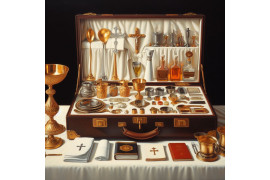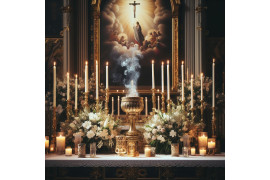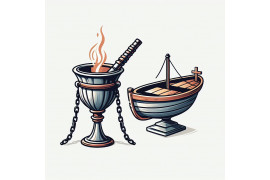The cross, a symbol that holds deep significance in Christianity, has a rich history that predates the religion itself. Used by various ancient civilizations, it was adopted by early Christians as a representation of their faith in Jesus Christ. Over time, different styles of crosses emerged, including the Latin cross, Greek cross, and Celtic cross. The crucifixion of Jesus Christ solidified the significance of the cross in Christianity, becoming a powerful symbol of sacrifice and redemption.
Throughout the Middle Ages and into modern times, the cross continued to hold its place as an important religious emblem. It also found its way into heraldry, where it adorned coats of arms and flags. Today, churches around the world utilize different styles of crosses in their architecture and worship practices.
Join us as we uncover fascinating details about this enduring emblem of faith.
Protestant Reformation Impact on Church Cross Usage
During the Protestant Reformation, which took place in the 16th century, there were significant changes in the way worship was conducted within Christian churches. This movement, led by reformers such as Martin Luther and John Calvin, questioned many practices of the Catholic Church and sought to bring about reforms based on Scripture. One area that underwent scrutiny during this time was the use of physical symbols like crosses in worship.
Reformers' Questioning of Physical Symbols
Some reformers expressed concerns about the use of physical symbols, including crosses, in religious practices. They believed that these symbols could potentially distract from true worship and devotion to God. Instead, they emphasized a more direct approach to worship through prayer, scripture reading, and preaching.
Focus on Scripture Over Visual Representations
As Protestant churches emerged from the Reformation period, there was a shift towards prioritizing Scripture as the central focus of worship. Visual representations such as crosses began to be downplayed or even removed from church buildings altogether. The emphasis now rested on understanding and applying biblical teachings rather than relying on physical symbols.
Emphasis on Simplicity and Direct Worship
Many Protestant denominations embraced simplicity in their approach to worship after the Reformation. They aimed to remove any distractions that might hinder a direct connection with God. Some churches opted to remove crosses from their buildings as part of this pursuit of simplicity.
Remembrance of Christ's Sacrifice
Despite these changes brought about by the Reformation, it is important to note that many Protestant churches still incorporate crosses into their worship spaces today. For them, the cross serves as a powerful reminder of Christ's sacrifice for humanity's sins. It symbolizes redemption and salvation through faith in Jesus Christ.
While some Protestants may have reservations about using physical symbols like crosses in worship due to concerns over idolatry or distraction from true devotion, others view them as meaningful reminders of their faith. The presence or absence of crosses in Protestant churches can vary depending on the denomination and individual church's beliefs.
Crucifix as a Symbol of Christ's Sacrifice in Catholic Churches
In Catholic churches, the use of crucifixes is highly significant and deeply rooted in their faith. These large crucifixes prominently display Jesus' body on the cross, symbolizing his sacrificial death for humanity's salvation. This powerful image serves as a constant reminder of Christ's suffering and love for mankind.
During Mass and other Catholic rituals, the crucifix takes center stage, serving as a focal point for prayer and reflection. As Catholics gaze upon the crucifix, they connect with Christ's sacrifice on a profound level, deepening their understanding of his suffering and reinforcing their devotion to him.
The presence of crucifixes extends beyond church walls into Catholic homes. Many faithful Catholics have a crucifix displayed in their homes as a visual reminder of their faith and devotion. It serves as a daily inspiration to live according to Christ's teachings and to seek forgiveness through his sacrifice.
The tradition of using crucifixes can be traced back to ancient times, when the crucifixion was a common form of capital punishment. The Romans used this method to execute criminals, including Jesus himself. The early Christians adopted the cross as a symbol of their faith, embracing its significance in representing Christ's ultimate act of love.
It is important to note that while both Western and Eastern Christian traditions use crosses as symbols, there are slight differences in their depictions. Western crucifixes typically feature an image of Jesus' body nailed to the cross with arms outstretched horizontally along the crossbar. On the other hand, Eastern crucifixes often depict Jesus with arms raised upwards at an angle, forming an upward "V" shape known as the "Crux Gemmata."
The Roman Catholic Church places great emphasis on displaying crucifixes throughout its churches worldwide. They serve not only as religious symbols, but also as visual reminders for believers to reflect upon Christ's sacrifice and find solace in his love and forgiveness.
In addition to their religious significance, crucifixes can also be seen in secular contexts. For example, the national flag of Scotland, known as the Saltire, features a white diagonal cross on a blue background. This cross shape is derived from the Christian crucifix and represents the martyrdom of Saint Andrew, the patron saint of Scotland.
To summarize, crucifixes play a vital role in Catholic churches by symbolizing Christ's sacrifice for humanity's salvation. They serve as focal points for prayer and reflection during Mass and other rituals. The presence of crucifixes in Catholic homes serves as a constant reminder of faith and devotion. Whether displayed within church walls or incorporated into national flags, the cross remains an enduring symbol that resonates with believers worldwide.
Depicting Christ's Triumph: Churches Prioritizing Resurrection over the Cross
In addition to Catholic churches, there are Christian denominations that place a greater emphasis on celebrating Christ's resurrection rather than focusing solely on his suffering on the cross. These churches utilize various symbols and imagery to represent Jesus' victory over death and the hope, joy, and new life that comes through faith in Him.
Empty Crosses and Symbols of Victory
Instead of displaying crucifixes with Jesus hanging on the cross, these churches often use empty crosses or other symbols like an empty tomb to depict Christ's triumph over death. The empty cross symbolizes Jesus' resurrection and the promise of eternal life for believers. It serves as a reminder that Jesus is no longer on the cross but has conquered death and is alive.
Conveying Hope, Joy, and New Life
By emphasizing resurrection rather than focusing solely on the crucifixion, these churches seek to convey messages of hope, joy, and new life found in Jesus Christ. The resurrection signifies victory over sin and death, offering believers the assurance of forgiveness and eternal life. This emphasis reflects theological differences among Christian traditions regarding salvation and redemption.
Theological Significance
The choice to prioritize resurrection over the cross stems from differing theological perspectives within Christianity. While all Christians recognize both the crucifixion and resurrection as essential aspects of Jesus' redemptive work, some emphasize one aspect more prominently than others.
For example, certain Protestant denominations highlight God's grace in providing salvation through faith alone in Christ's finished work on the cross. They view the cross as a symbol of God's love demonstrated through Jesus' sacrifice for humanity's sins.
On the other hand, churches that focus primarily on resurrection may emphasize God's power over death and His ability to grant believers eternal life. They see it as a representation of victory over sin and offer a message of hope for those who believe in Jesus.
The Impact of Art and Symbolism
Art plays a significant role in depicting the resurrection in these churches. Paintings, sculptures, and other forms of artwork often portray Jesus emerging from the tomb or ascending to heaven, showcasing His triumph over death. These visual representations serve as powerful reminders of the hope and new life that believers find through faith in Christ.
In Eastern Orthodox Christianity, icons play a crucial role in conveying theological truths. Icons of the Resurrection depict Christ standing on the shattered gates of hell, pulling Adam and Eve out of their tombs, symbolizing liberation from sin and death for all humanity.
Celebrating Resurrection Worldwide
The emphasis on resurrection is not limited to specific regions or denominations, but can be found across various Christian traditions worldwide. Whether it's through art, symbols, or theological teachings, churches prioritize resurrection as a central theme to highlight the victory and glory of Jesus Christ over death.
Varying Depictions of the Cross among Christian Denominations
Different Christian denominations have their own unique ways of depicting the cross, reflecting cultural influences, theological beliefs, and individual preferences within various traditions. Let's explore some of the variations in how churches use the cross.
Various Styles of Crosses
Christian denominations may utilize different styles of crosses in their worship spaces. Some common examples include:
-
The Latin Cross: This is the most widely recognized style, with a longer vertical line intersecting a shorter horizontal line.
-
The Greek Cross: In this style, all four arms of the cross are equal in length, creating a symmetrical design.
-
The Crucifix: Unlike other styles that depict an empty cross, the crucifix includes a representation of Jesus on the cross.
Size and Prominence
The size and prominence of the cross within church buildings can also vary among denominations. While some churches may have large crosses prominently displayed at the front or center of their sanctuaries, others may have smaller crosses placed on altars or behind pulpits. The significance placed on the physical presence of the cross varies from denomination to denomination.
Artistic Elements and Embellishments
The way crosses are adorned can differ greatly among Christian churches. Some denominations prefer a more simplistic design, with plain wooden crosses or minimalistic metalwork. On the other hand, certain churches incorporate artistic elements into their crosses. These artistic embellishments might include intricate carvings, colorful stained-glass inserts, or even precious gemstones.
Cultural Influences
The depiction and usage of crosses can also be influenced by cultural factors. For example:
-
In predominantly Catholic nations like Italy or Spain, you may find ornate crucifixes adorning church walls.
-
Protestant denominations often favor simpler designs that emphasize faith rather than elaborate ornamentation.
These variations reflect how different cultures interpret and express their religious beliefs through the visual representation of the cross.
Theological Beliefs
The differences in how churches use the cross can also stem from varying theological beliefs. Some denominations place a greater emphasis on Christ's resurrection and may choose to depict an empty cross, symbolizing triumph over death. Others may emphasize Christ's sacrifice and redemption, using crucifixes to depict Jesus' suffering on the cross.
Beyond Religious Context: Symbolic Uses and Historical Significance of the Cross
Throughout history, the cross symbol has been used in various contexts beyond its religious significance. It has represented concepts such as balance, unity, and protection. In ancient times, the cross was associated with pagan deities and wielded as an emblem of power by rulers. However, it was the crucifixion of Jesus Christ that transformed the meaning of the cross into a powerful symbol of love, sacrifice, and redemption.
The symbolism associated with the plain cross extends far beyond its religious connotations. Let's explore some of these uses and delve into the historical significance behind this iconic symbol.
Symbolism in Non-Religious Contexts
The cross has been employed as a symbol in different cultures throughout history. In ancient Egypt, for example, it represented life and fertility. The Ankh cross featured a loop at the top, signifying eternal life. Similarly, Native American tribes incorporated crosses into their artwork to represent harmony and balance.
Historical Significance
In ancient times, before Christianity emerged as a dominant religion, the cross held diverse meanings across civilizations. The Egyptians saw it as a protective amulet against evil spirits, while Nordic cultures viewed it as a symbol of cosmic order and connection between worlds.
During Roman rule, crucifixion was a common form of execution, reserved for slaves and criminals. The Romans used crosses to instill fear among their subjects while asserting their authority over conquered territories.
Transformation through Christianity
The crucifixion of Jesus Christ marked a pivotal moment in history that forever changed the meaning attached to the cross symbol. Christians believe that Jesus willingly sacrificed himself on the cross to redeem humanity from sin.
Following Christ's death and resurrection, early Christians adopted the cross as a central emblem of their faith. It became synonymous with love, forgiveness, salvation, and eternal life.
Broader Cultural Significance
Today, not only is the cross universally recognized as a symbol of Christianity, but it also holds broader cultural significance. It is often used to represent hope, strength, and perseverance. The cross has found its way into various aspects of daily life, from jewelry and tattoos to artwork and architecture.
In popular culture, the cross is frequently depicted in movies, music videos, and fashion. It has become a trendy fashion statement for many individuals who may not necessarily identify as religious but appreciate the symbol's aesthetic appeal or associate it with personal beliefs.
Reflecting on Diverse Practices of Cross Usage in Churches
In exploring the diverse practices of cross usage in churches, it becomes evident that different Christian denominations approach this symbol with varying perspectives and interpretations. The Protestant Reformation had a significant impact on the use of the cross, with some branches of Protestantism opting for simpler crosses devoid of religious imagery. On the other hand, Catholic churches prominently display crucifixes as a symbol of Christ's sacrifice, emphasizing devotion and reverence. Some churches prioritize the resurrection over the cross itself, depicting Christ's triumph rather than focusing solely on his crucifixion.
Understanding these varied approaches to the cross within different Christian traditions provides valuable insight into the rich tapestry of religious practices. It highlights how symbols can hold deep significance and meaning for believers, while also allowing for personal interpretation and expression. Exploring historical contexts and theological perspectives surrounding the use of the cross enhances our understanding of its symbolic power.
As you continue your exploration into this topic, consider delving deeper into specific denominational practices or investigating how cultural influences have shaped these diverse approaches to using the cross in churches. By gaining a comprehensive understanding of these practices, you can engage in meaningful discussions about religion and symbolism while fostering an appreciation for different perspectives.
FAQs
What is the significance of using a crucifix instead of a plain cross?
The use of a crucifix in Catholic churches holds great significance, as it represents Christ's sacrifice on the cross for humanity's salvation. The presence of Jesus' body on the crucifix serves as a reminder of his suffering and ultimate triumph over death.
Why do some Protestant churches prefer simpler crosses without religious imagery?
Protestant churches often emphasize simplicity in their worship practices, seeking to focus more on biblical teachings rather than visual representations. The use of plain crosses reflects this emphasis by highlighting Jesus' message rather than emphasizing his physical form or suffering.
Are there any denominations that prioritize the resurrection over the cross?
Yes, some Christian denominations place a greater emphasis on Christ's resurrection as a symbol of victory and redemption. They may choose to depict an empty cross or emphasize imagery related to the resurrection, such as an empty tomb.
How do different Christian denominations interpret the meaning of the cross?
Interpretations vary among Christian denominations. While some view, the cross primarily as a symbol of sacrifice and atonement, others see it as a representation of triumph over sin and death. The specific theological teachings and traditions within each denomination shape their interpretations.
Can non-Christian religions also use the cross as a symbol?
Yes, in addition to Christianity, various non-Christian religions have used the cross as a symbol throughout history. However, it is important to note that these religious traditions often attribute distinct meanings to the symbol that may differ from its significance within Christianity.



